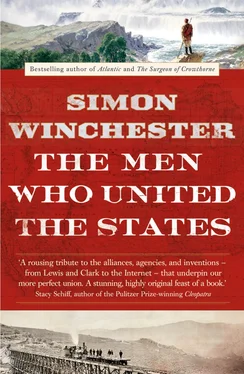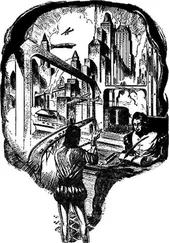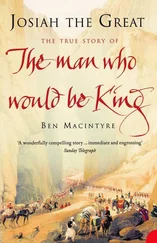It is at moments like this the irony of history presents itself. For it seems not too much of a stretch to suppose that America’s present-day global reach, insisted upon as a right and represented by weapons like this, is a concept that actually enjoyed its infancy here, more than two centuries ago. This was when two young soldiers, on orders from their president, were engaged on a mission to extend the reach of their young country, not then clear across the world, but from just one gray ocean clear across to another. The world would come later, when canoes became bombers and wooden paddles jet engines.
THE WOOD WAS BECOME GRASS
Beyond Kansas City the river turns northward, and William Clark offered his views about the kind of terrain that he believed now lay on its western bank. His spelling and grammar were never exemplary: on the evening of June 21, 1804, when he wrote this simple observation, he was probably quite weary:
Supplied with water the Small runs of (which losees themselves in the bottom land) and are covered with a variety of timber such as Oake of different Kinds Blue ash, walnut &c. &c. as far as the Praries, which I am informed lie back from the river at some places near & others a great distance.
The Praries , as he had it, were indeed nearby, and they were of a landscape very different from what had gone before.
Until this point in the journey, the expedition had been quite overwhelmed by trees, by forests, by glades, by copses—by wood. The valleys through which the men traveled and the hills they saw from the water were usually thick with trees. They were burned in some places by Indians, who needed places to conduct their agriculture, but otherwise they seemed totally to carpet the land. Red and white pine forests; oak and chestnut forests, copses of hickory and cottonwood; groves of aspen, birch, maple, and cedar; stands of balsam fir, oak, ash, and walnut—all these and more make their way into the journals of Lewis and Clark, for whom scarcely a day went by without some mention of a tree or a wood or the worrisome absence of woodland where the explorers had believed it should be.
Though Lewis had some scant botanical training, the two were focused primarily on the commercial possibilities of timbering, not forest science per se. Early America ran on wood. People had an urgent need of it for every aspect of life, from fuel to housing, from boatbuilding to the making of crude paper and the construction of that most esteemed emblem of pioneer life, the log cabin. And in those settled parts of the country, wood was abundant. From the white pine forests of Maine to the magnolias of South Carolina and the elms and chestnuts, the cottonwoods and willows of Missouri Territory, the stripling America was bristling with trees.
Except, as William Clark was aware, this suddenly was not so anymore, on the west bank of the upper reaches of the Missouri River. Up on these riverbanks, sometimes close to the river, on other occasions some great distance away, and first seen in the long reaches upstream from where the river makes its directional shift from the west to the north, there appeared glimpses of a landscape now in a state of arboreal undress, much changed from what had gone before.
What Clark glimpsed was a relatively treeless brown-green country, stretching away into a violet horizon that was longer and flatter than any that these hill-born Easterners had ever witnessed or imagined before. It was landscape laid out, flatly undulating, beneath a sky so big it was overwhelming. It was a new kind of prairie, a limitless tableland of grass, a huge grazing-plain, with a wind that soughed near-constantly above the vegetation, the temperature of the drifting air the only clue to the season. Its sky was flecked with mare’s tails of clouds, where lightning could be seen a hundred miles distant and you could watch the black storms chewing their way toward you, the sky suddenly darkening overhead as the squalls arrived and smashed down wafting curtains of hail until the earth was quite white and crunched underfoot, though within moments the reappearing sun then melted it away, steam suddenly began to rise from the grass, and you could almost hear the plants bursting upward in the newly made and richly damp sauna of heat. America was someday to be a united nation, for sure, but in places its newly seen landscape evidently comprised the greatest imaginable differences.
The explorers had reached the eastern edge of that immense, hitherto mostly unseen and uniquely American geographical phenomenon: the Great Plains. Uniquely American, but not unique: there is no shortage of vast midcontinental expanses elsewhere—the Russian steppes, the African veldt, the Argentine pampas, and even some African savannas all offer much the same confluence of flattened topography, pitiless windblown climate, and endlessly unvarying botanical covering. But in America, the Great Plains have been sintered into what is now a cultural, as well as a geographic, entity—a tract of thinly settled grassland of between half a million and a million and a half square miles, depending on the chosen boundaries, a place and an entity that is now an essential component of what America has made of herself, part of the country’s shared triumph and, for many years, part of the narrative of her shared national tragedy, too.
The Great Plains boundaries are fugitive, vague lines that shift from year to year, drift from climate to climate, or wander and wobble like the polar axis. The sudden upsurge of the Rocky Mountains more or less marks their western limit. In the east, where Lewis and Clark became the first confirmed American explorers to encounter them, 5their boundary is ill defined at best. Some like to suggest that the Missouri itself provides the line. The land on the river’s eastern side is thick with lush vegetation, the soil so Russian black and damp and rich that some have remarked that it might as well be eaten without any need to pass vegetables through it. The lands on the far side, by contrast, are said to be parched and dusty, their grasses scrawny and patchy, and such meadows as exist having a persistent brown and sun-scorched look about them. But this is all a fancy; scarcely anywhere along the river is the division ever so neat and clear-cut. In fact, seldom can a traveler from the east be entirely sure he has truly entered the plains proper until their presence, after miles of slow and subtle alterations, becomes fully—and to some stunningly, even alarmingly—obvious. And that has little to do with the changing nature of soils or vegetation: it is generally when all the visible world around seems sky and endless curved horizons, where nothing else seems to exist before or behind or on either side but an apparently limitless, wind-hissing emptiness.
Though geology and glacial history have determined the extent and topography of the plains, it is quite simply rainfall—or rather, its lack—that is the real key to their existence. The climate patterns here are so classic that they might be lifted from a textbook. The huge, moisture-laden weather systems that trundle relentlessly eastward across the continent from the Pacific Ocean are forced upward as they pass over the Sierra Nevada and the Rockies; this ascent cools the air, reducing its capacity to hold water. Gravity then insists it fall as rain or snow on the crags below.
What happens next determines the fate of the plains; by the time the weather systems are done with the mountains and swish downward from the heights on their eastward drift, they are exhausted, wrung out, and bone-dry. They roll on for hundreds of airborne miles without immediate purpose, without maturing clouds, and without the will or ability to deposit any further moisture on the grounds below.
The flatlands beyond the Rockies thus lie in a rain shadow, and the vegetation that grows or clings to life within it is peculiar and appropriate to the waterlessness it imposes. And since the vegetation is almost always the key to both animal and human settlement, the role of these flatlands in at least the beginnings of the American story was as fully determined by it as in any other settled corner of the planet. Just as the Inuit and the polar bear inhabit the northern snow country, just as the Tuareg and the camel make their own very different kind of living in the hot African deserts, and just as the San and the Yamana and the Ainu and the Kazakh all adapt to their own unique habitats according to climate, topography, and the local flora and fauna, so too in these prairie parts one finds people and creatures uniquely suited to the conditions: the Comanche and the prairie dog, the Sioux and the rattlesnake, and all of the other Plains Indians—the Blackfoot, the Cheyenne, the Arapaho, and the Crow—together with uncountable millions of the single species of animal that once so dominated and symbolized the grass-covered landscapes here, the American bison.
Читать дальше












